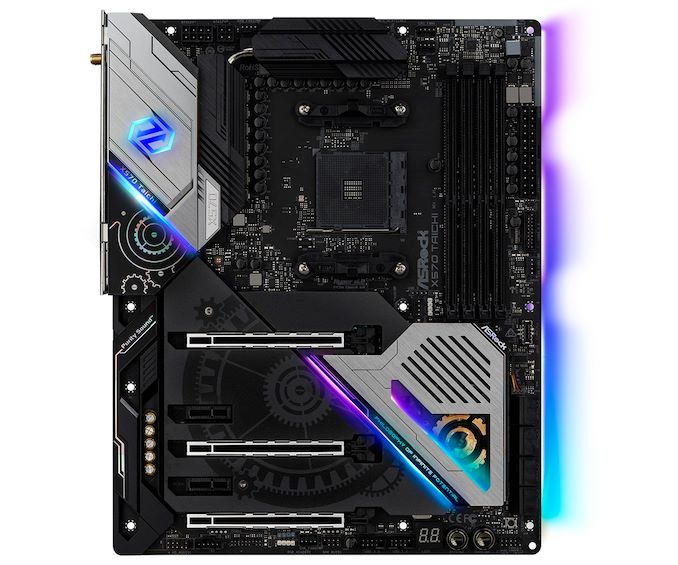The AMD X570 Motherboard Overview: Over 35+ Motherboards Analyzed
by Gavin Bonshor on July 9, 2019 8:00 AM ESTASRock X570 Taichi
Moving a step down the product stack from the X570 Aqua is the ASRock X570 Taichi which includes a new RGB inspired design, and shifts away from the usual black and white Taichi theme. While still targetted at premium users and enthusiasts, the ASRock X570 Taichi is representative of one of its most well-known lines which in previous generations has combined quality, performance, and a solid feature set at a reasonable price point. The ASRock X570 Taichi also uses its fabled signature cogwheel design across the board covers and integrates ARGB into multiple areas.
The ASRock X570 Taichi redefines the range and marks a change in aesthetics across the entirety of the board. On the majority of the board is its memorable cogwheel design is still a main element of the design but it now includes black heatsink armor around the PCIe slot area. The X570 chipset is actively cooled by a fan, mainly due to the X570 chipsets tendency to run warmer than previous generations. On the rear panel cover as with the chipset heatsink is ARGB for users looking to make a visual statement with their system. The X570 Taichi uses a 14-phase power delivery and has one 8-pin and one 4-pin 12 V CPU power inputs.
On the X570 Taichi is three full-length PCIe 4.0 slots operating at x16, x8/x8, and x8/x8/x4, with two PCIe 4.0 x1 slots. Underneath the heatsink armor is three PCIe 4.0 M.2 slots, while the board also supports up to eight SATA devices. For users looking for Thunderbolt connectivity, a Thunderbolt AIC 5-pin connector is present, but support is limited to ASRock's separately supplied AIC card. A total of four memory slots with support for DDR4-4666 are present, with a maximum supported capacity of up to 128 GB.
On the rear panel is a single Intel I211-AT Gigabit port, and also includes the new 802.11ax Killer AX1650 Wi-Fi 6 wireless adapter. There are three USB 3.1 G2 Type-A, a single USB 3.1 G2 Type-C, and four USB 3.1 G1 Type-A ports. An HDMI video output is present for users looking to use the integrated graphics on Ryzen APUs, while there's five 3.5 mm color coded audio jacks and S/PDIF optical output which is powered by a Realtek ALC1220 HD audio codec. For legacy users, a PS/2 combo port is featured, along with a BIOS Flashback button and a button to reset the CMOS.
The ASRock X570 Taichi has an MSRP of $300 and represents one of its most recognisable ranges for the last decade. Users looking for a mid-range option with plenty of features including triple PCIe 4.0 x4 M.2 slots, plenty of SATA, and solid power delivery will be hard pushed to find a better board in its price range.












225 Comments
View All Comments
abufrejoval - Tuesday, July 9, 2019 - link
It's amazing how quickly you run out of PCIe lanes, when you don't have switches to multiplex and translate between PCIe revisions and lanes (e.g. PCIe v4 x2 <-> PCIe v2 x8).I find myself using USB 3.x NBase-T NICs and NVMe adapters, simply because they *do* switch.
Bensam123 - Tuesday, July 9, 2019 - link
Maybe a bit more depth on the power delivery page. I have absolutely no idea how to go about parsing what's there. More chokes is better? What denotes a power phase?A5 - Tuesday, July 9, 2019 - link
+1. Some analysis of that information would be helpful.MrSpadge - Tuesday, July 9, 2019 - link
+1bunkle - Wednesday, July 10, 2019 - link
The controller column includes the total number of phases supported split between CPU cores and SoC e.g. (6+1) = 6 CPU phase and 1 SoC phase. More is *usually* better but has diminishing returns regarding tighter and tighter voltage regulation. Some controllers are better than others (can operate at high frequency e.g. 500KHz v 1000KHz, include other features to improve performance) mitigating the need for more phases.Each phase is a buck converter comprised of a low/high side MOSFET (can be integrated in a single package) and choke. Some controllers can support doubling up the PWM signal to driver more MOSFETs. Doublers can also be added as discrete components if not built into the controller.
Current rating of the MOSFET (e.g. Sic639=40A IR3555=60A) indicates the total power deliverable. MOSFETs are not 100% efficient and vary in efficiency. The more current they provide the hotter they get and the less efficient they become, with better MOSFETs producing less heat for a given current. Thus using doubles can improve temperatures and efficiency without the benefits of the tighter voltage tolerance that *real* phases provide.
Hope that’s helpful!
bunkle - Wednesday, July 10, 2019 - link
A lot more detailed explanation: https://en.wikichip.org/wiki/voltage_regulator_mod...bug77 - Tuesday, July 9, 2019 - link
The description for AsRock X570(M) Pro4 says "5 jack + 1 SPDIF". Unfortunately, those boards lack SPDIF and only come with 3 jacks ;)Smell This - Tuesday, July 9, 2019 - link
I'm thinking the *ASRock Thunderbolt AIC* ...https://thunderbolttechnology.net/product/asrock-t...
would cover all your TBT peripheral needs, including optical.
DanNeely - Tuesday, July 9, 2019 - link
Do X570 boards still need an extra chip per USB port to support USB-C reversibility?The additional expense and needed PCB space were cited as among the reasons why earlier generation boards (IIRC both Intel and AMD) almost never had more than 1 C port; but it was never clear to me if that was an inherent implementation penalty for the C port or an artifact of Intel's tech stack being stalled out and AMD outsourcing to ASMedia which built the chipsets on an ancient (55nm) platform.
DigitalFreak - Tuesday, July 9, 2019 - link
Gavin - X370 and X470 only supported PCIe 2.0. The connection between the CPU and chipset was 3.0, but all the ports on the chipset were 2.0.